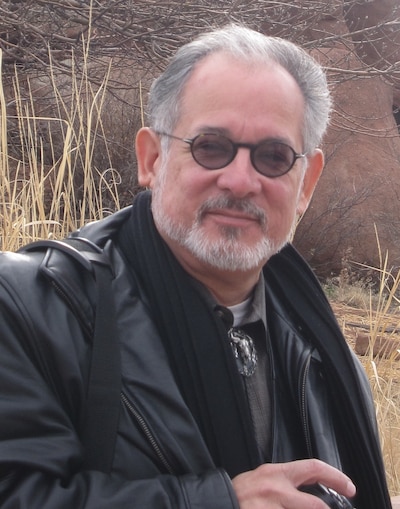Michael Bautista had a dream-crushing moment in high school when his counselor suggested he wasn’t college material.
It was a shocking assessment for the teenager. He’d always hoped to attend college and

was active in sports, band, orchestra, and choir. But his counselor had trained her attention on his middle-of-the-road ACT scores.
Bautista went on to earn a Ph.D. and today teaches construction at the Boulder Valley district’s Technical Education Center. He’s also a member of the state’s Commissioner’s Teacher Cabinet, a group of educators that provides input to the Colorado Department of Education on the impact of education policies in the classroom.
He talked to Chalkbeat about what came out of that demoralizing high school moment, teaching students to build space habitats, and how he learned about dyslexia.
This interview has been lightly edited for length and clarity.
Was there a moment when you decided to become a teacher?
I was teaching theatrical design and technical directing at the University of Tulsa when I took a job as a consultant for a local school district that was building a performing arts center. I was asked if I would be interested in teaching theatrical design and stagecraft two hours a day at the high school. I hadn’t considered teaching at the high school level, but I thought, “Let’s give it a try.”
I truly enjoy teaching and working with the high school age group because with the right teaching methods they can do just as well as or even better than many college students.
Tell us about your own experience with school and how it affects your work today.
In high school, I played sports, and was in the band, orchestra, and vocal music groups. During my senior year in high school, the counselor sat me down and asked what I was going to do with my life after high school because I certainly couldn’t go to college. That surprised me because I had always dreamed of going to college.
That was the first time I had seen my counselor, and she based everything on my ACT score, which was average. From that point on, I thought if I ever deal with students I will never tell them they can’t do something they have been dreaming about.
I decided to go to college and did extremely well, with an undergraduate degree in music education in voice and opera, a master’s degree in technical theater and design, and a Ph.D. in fine arts administration. I also went back to get my superintendent and principal’s licenses.
You’re a big advocate of project-based learning. Tell us more.
The first experience I had with project-based learning was a project I created for an independent study course I took during my senior year in high school. I did a film on the Delaware Indians in Kansas. When I finished it, the Kansas Historical Society wanted a copy and I was written up in the Kansas City Star. Because of this experience, I never forgot how important it was to have students achieve this kind of success in their own work.
What was your biggest misconception that you initially brought to teaching?
When I taught college students, the courses were leveled, with introductory, then intermediate, and finally advanced classes. At each level, students had to stay inside these confines and couldn’t do anything else.
When I began teaching stagecraft and theater design in high school, I got a lot of pushback from students. Some of them had some stagecraft experience and some had design experience. They didn’t want the course to mirror their other high school classes. They felt I was holding them back.
That’s when I decided to create a program where I gave them a project and they would ask for my help when needed. I designed each project with parameters to see if they understood the information. With project-based learning, students could attain any level they wanted and achieve spectacular results because they set their own expectations for each project.
You teach construction trades. What kinds of things do students learn and build in your classes?
I teach the students about the process of construction because the construction industry is not just about the trades. It’s much bigger than that. I take students through the entire process from buying the property to turning it over to the client. To do this, students design their own home, first by hand then using SketchUp, AutoCad, and other computer programs. Students must create technical documentation, including a site layout, a soils report, and an environmental impact study. They also do a bid estimation and form their own company with a logo they create.
By the time they have completed the project, they have a package they could potentially get a permit with to build their home. On top of that, they study for and receive their CPR/first aid certification and OSHA 10 certification, which requires a 10-hour course on workplace safety and health. Students also do 80 hours of building time with Habitat for Humanity and receive college credit for the course.
What was the biggest challenge you faced in your job over the past year?
Teaching construction online. I became very innovative and they actually had to do some projects for their home. One student worked with his dad doing decks and one worked with a friend building a goat house. Another student built a bunk bed with a desk underneath it. Projects like this helped them use the tools they had at home and give their parents something that was needed.
The schedule that the students and I agreed upon were two days working on the computer: one day where I presented the material they needed to do their project and one day for a speaker to talk about the construction industry. I had only one student who had trouble with internet access so it was difficult for him. I told him when he had trouble with the internet connection, he could text me and keep in touch with me that way.
Tell us about a favorite lesson to teach. Where did the idea come from?
The space construction unit is the most fun. Students are required to create 3D models of three habitats: one for outer space, one for the moon, and one for Mars. These are conceptual drawings, but they have to meet specific requirements that protect the person from various conditions associated with each environment. All the habitats have to have an isolation unit because of what we are still experiencing with COVID. So far, I have brought in two speakers to talk to them about the moon and Mars. The third speaker is an astronaut who will critique their habitats.
This idea came from a friend whose son was interested in space. He didn’t enroll in my program, but I thought, “Why not teach a unit in space construction because this is the generation that will be doing the building on the various planets and in outer space?”
Tell us about a memorable time — good or bad — when contact with a student’s family changed your perspective or approach.
My most memorable contact with a parent was when I was the principal of the Denver School of the Arts. Her child had dyslexia and she was being very proactive for her son. She asked me if I wanted to understand what students who had dyslexia had to go through when they were trying to learn in the traditional format. I read the books she gave me, which taught me how to help students with dyslexia. Learning this was life changing.








